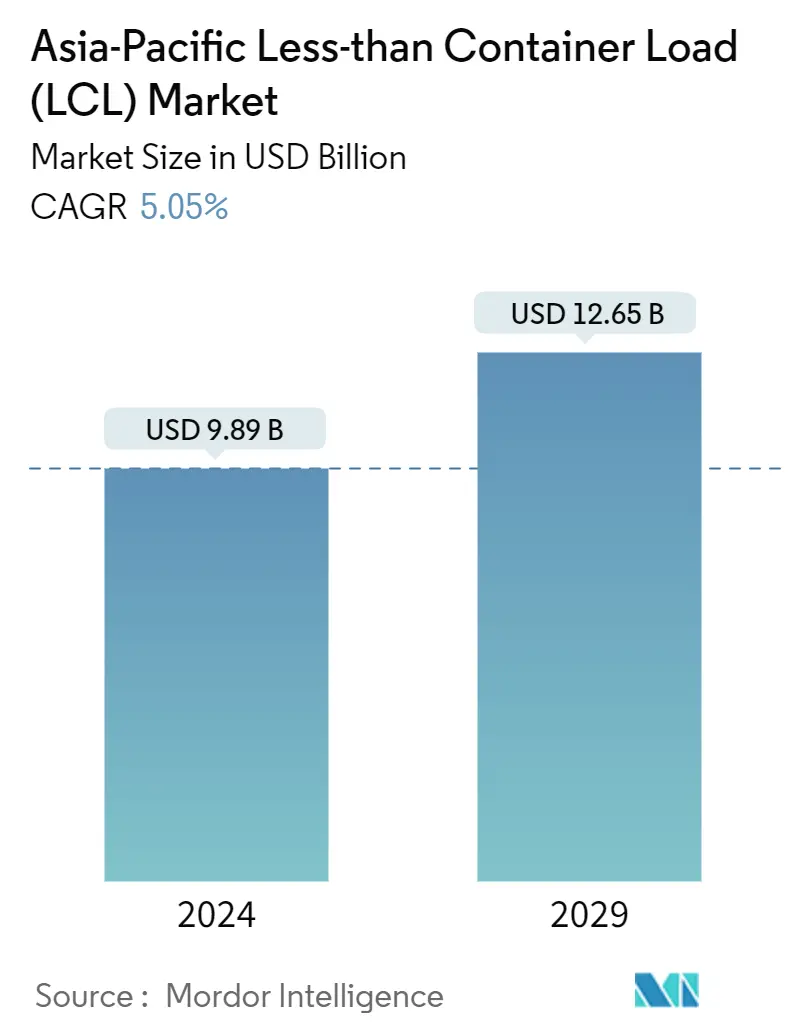Market Size of Asia-Pacific Less-than Container Load (LCL) Industry

| Study Period | 2019-2029 |
| Base Year For Estimation | 2023 |
| Market Size (2024) | USD 9.89 Billion |
| Market Size (2029) | USD 12.65 Billion |
| CAGR (2024 - 2029) | 5.05 % |
| Market Concentration | Low |
Major Players
*Disclaimer: Major Players sorted in no particular order |
Asia-Pacific Less-than Container Load (LCL) Market Analysis
The Asia-Pacific Less-than Container Load Market size is estimated at USD 9.89 billion in 2024, and is expected to reach USD 12.65 billion by 2029, growing at a CAGR of 5.05% during the forecast period (2024-2029).
The market is driven by the increasing sea freight in the region. Furthermore, the market is driven by the decreasing rates due to uncertainties in the market.
According to Dimerco, intra-Asian ocean freight rates are "sliding," although the market is holding up better than long-haul shipments. The Taiwanese forwarder stated in its September 2022 Asia-Pacific freight report that demand for maritime freight was deteriorating globally owing to the economic crisis and inflation, with macro data not indicating a speedy reversal. Overall, ocean loading factors ex-Asia for long-haul shipments decreased by 94%, according to Dimerco. In the coming weeks, the percentage could fall to 92% or such. Low demand has resulted in falling maritime freight charges. Intra-Asian rates from Southeast and Northeast Asia are also falling but remain reasonably constant when compared to rates into and out of China. Indeed, the South-East Asia Freight Index decreased by 2.5% in September 2022, while the Shanghai Containerised Freight Index sank by 10.4%.
Because of the increased trade among RECP countries, as well as the raw material transport required for the manufacturing move from China into Southeast Asian countries, cargo traffic within this region is still highly active. According to Maersk's most recent Asia-Pacific report, intra-Asian and intra-African trades were the only ones to have container volumes rise by 3.7% between May and July 2022. Changes in the macroeconomic climate are hastening market normalization and allowing ports to decongest, putting pressure on the value proposition supplied by carriers. Maersk claimed that overall demand for Asia-Pacific-Indian Subcontinent maritime freight was dropping due to the economic environment in destination regions and that automotive volume has been impacted by Pakistan's economic condition and also flooding.
Global shipping is confronting several challenges. While container rates are falling significantly, contract rates are approaching spot rates. This tendency is visible in other places, such as China and Southeast Asia, where, despite the drop in container rates, demand for shipping remains weak due to global inflation and constrained demand, resulting in a large drop in freight prices. Container costs have declined dramatically in key Asian ports such as Ningbo, Shanghai, and Singapore in the last year, indicating that the current situation may stay shortly. Container trends are an important indicator of economic success and global trade, and the market picture now appears grim. Container pricing and leasing rates are falling as the global shipping industry is witnessing a freefall in container rates.
After the Chinese New Year, container volumes and rates remain low, indicating a shift in the shipping business. An overstock of containers had resulted in carriers wishing to sell their inventory by October 2022. Spot rates, contract rates, and container prices have all plummeted dramatically as a result of global inflation and limited demand, with one key Asia-US route suffering an 80% decline in freight pricing. Furthermore, container prices remained low, with Asia-US West Coast rates 11% lower in January 2023 than in January 2020 and Asia-US East Coast rates 84% lower in January 2023 than in January 2022. Consumer demand in North Europe, in addition to Asia-US transportation routes, is unlikely to improve very soon.
Asia-Pacific Less-than Container Load (LCL) Industry Segmentation
LCL stands for less than the container load. It refers to circumstances in which the cargo has modest volumes or dimensions that do not require the complete volume of a container. The shipper can choose LCL, which combines their shipment with other smaller cargoes in this example. A consolidated container is one in which numerous smaller goods are merged to be shipped in the same container. A complete background analysis of the Asia-Pacific Less-than-Container Load (LCL) Market, including the assessment of the economy and contribution of sectors in the economy, a market overview, market size estimation for key segments, emerging trends in the market segments, market dynamics and geographical trends, and COVID-19 impact, is covered in the report.
The Asia-Pacific less-than container load (LCL) market is segmented by destination (domestic and international), end-user (manufacturing, retail (including e-commerce), healthcare and pharmaceuticals, agriculture, and other end-users), and country (Australia, China, India, Indonesia, Japan, Malaysia, Thailand, Vietnam, and other Asia-Pacific countries).
The report offers market size and forecast values (USD) for all the above segments.
| By Destination | |
| Domestic | |
| International |
| By End User | |
| Manufacturing | |
| Retail (Includes E-commerce) | |
| Healthcare and Pharmaceuticals | |
| Agriculture | |
| Other End Users |
| By Country | |
| Australia | |
| China | |
| India | |
| Indonesia | |
| Japan | |
| Malaysia | |
| Thailand | |
| Vietnam | |
| Other Asia-Pacific Countries |
Asia-Pacific Less-than Container Load (LCL) Market Size Summary
The Asia-Pacific Less-than Container Load (LCL) market is experiencing a dynamic phase characterized by a mix of challenges and opportunities. The market is projected to grow steadily over the forecast period, driven by increasing sea freight activities and the ongoing shift of manufacturing from China to Southeast Asian countries. Despite the overall decline in global maritime freight rates due to economic uncertainties and inflation, intra-Asian trade remains resilient, with significant cargo traffic facilitated by trade agreements among RECP countries. The market landscape is highly competitive, with numerous local, regional, and global players such as RHENUS LOGISTICS, CEVA Logistics, and A.P. Moller-Maersk actively participating. These companies are under constant pressure to optimize operational efficiency and reduce costs, which is prompting a wave of mergers and acquisitions in the region.
The current state of the global shipping industry presents a complex scenario, with container rates falling significantly and demand showing signs of weakness. This decline in rates is evident in key Asian ports, and the market is witnessing a convergence of contract and spot rates, indicating a lack of long-term demand commitments. While intra-Asian trade shows some resilience, the broader market outlook remains cautious, with expectations of slower economic growth and poor demand in certain regions. Policymakers in Asia are increasingly aware of the potential reconfiguration of global supply chains and its implications for their export-oriented economies. The region's trade integration, driven by rapid intra-industry trade and global value chains, continues to play a crucial role in its economic development, although the current market conditions pose significant challenges.
Asia-Pacific Less-than Container Load (LCL) Market Size - Table of Contents
-
1. MARKET INSIGHTS DYNAMICS
-
1.1 Current Market Scenario
-
1.2 Market Overview
-
1.3 Market Dynamics
-
1.3.1 Drivers
-
1.3.2 Restraints
-
1.3.3 Opportunities
-
-
1.4 Value Chain / Supply Chain Analysis
-
1.5 Porter's Five Forces Analysis
-
1.5.1 Bargaining Power of Suppliers
-
1.5.2 Bargaining Power of Buyers/Consumers
-
1.5.3 Threat of New Entrants
-
1.5.4 Threat of Substitute Products
-
1.5.5 Intensity of Competitive Rivalry
-
-
1.6 Impact of COVID-19 on the market
-
-
2. MARKET SEGMENTATION
-
2.1 By Destination
-
2.1.1 Domestic
-
2.1.2 International
-
-
2.2 By End User
-
2.2.1 Manufacturing
-
2.2.2 Retail (Includes E-commerce)
-
2.2.3 Healthcare and Pharmaceuticals
-
2.2.4 Agriculture
-
2.2.5 Other End Users
-
-
2.3 By Country
-
2.3.1 Australia
-
2.3.2 China
-
2.3.3 India
-
2.3.4 Indonesia
-
2.3.5 Japan
-
2.3.6 Malaysia
-
2.3.7 Thailand
-
2.3.8 Vietnam
-
2.3.9 Other Asia-Pacific Countries
-
-
Asia-Pacific Less-than Container Load (LCL) Market Size FAQs
How big is the Asia-Pacific Less-than Container Load Market?
The Asia-Pacific Less-than Container Load Market size is expected to reach USD 9.89 billion in 2024 and grow at a CAGR of 5.05% to reach USD 12.65 billion by 2029.
What is the current Asia-Pacific Less-than Container Load Market size?
In 2024, the Asia-Pacific Less-than Container Load Market size is expected to reach USD 9.89 billion.

